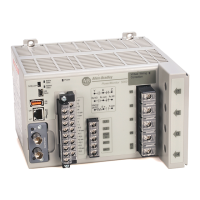Rockwell Automation Publication 1426-UM001J-EN-P - August 2019 223
Communication Chapter 9
PowerMonitor 5000 Unit
Memory Organization
Memory is organized like the memory of a ControlLogix® controller, by using
symbolic tag addressing. Support for PLC-5® or SLC™ 500 controller type
addressing is also provided. Data tables organize individual data items of similar
function. For example, real-time metering parameters voltages, current,
frequency, and power are grouped in one data table, and billing-related
parameters like demand and energy are in a second metering results table.
Appendix A
provides a comprehensive listing of the PowerMonitor 5000 unit
data tables.
Data Table Addressing
Data tables can be addressed in several ways.
Symbolic Addressing
Status and metering results data can be addressed by their tag names, similar to
the manner in which ControlLogix controller tags are addressed. Symbolic tag
addresses are displayed in the power monitor web page, and appear in an RSLinx
Classic software OPC topic configured for a PowerMonitor 5000 unit.
The following tables can be accessed using symbolic addressing:
• MeteringResults.Energy_Demand
• MeteringResults.RealTime_VIF_Power
• PowerQuality.RealTime_PowerQuality
• Statistics.Setpoint_Output
• Statistics.Setpoint_Logic
•Status.General
•Status.Communications
•Status.RunTime
• Status.Discrete_IO
•Status.Wiring_Diagnostics
• Status.TableWrites
• Status.Alarms
• Status.IEEE1588
CIP Addressing
Addresses are of the form Object:Instance:Attribute. CIP™ addressing allows
reading and writing of an entire data table (assembly instance) rather than
individual elements. In CIP addressing, the energy metering results table is
Object Class 4 (Assembly object), Instance 844
(MeteringResults.RealTime_VIF_Power
table on page 373), and Attribute 3
(data).

